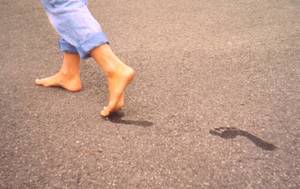People who run barefoot learn to minimise impact shock, adopting a different style of running from those in shoes, according to research published in Nature this week. This could help us to understand the impact-related injuries suffered by a high percentage of runners.
Daniel Lieberman and colleagues at Harvard University used kinematic and kinetic analyses to observe runners who were either habitually barefoot or who generally wore shoes. Both groups were asked to run in shoes and barefoot, and high-speed camera footage was taken to observe exactly how their feet moved. They also got volunteers to run over a force plate, to analyse how forces were transmitted during different kinds of running.
 There are three ways your feet can land when you're running - a rear-foot strike (RFS), landing on the heel first; a mid-foot strike (MFS), when the heel and ball of the foot land simultaneously; and a forefoot strike (FFS), in which the ball of the foot lands before the heel comes down. Sprinters and the habitually barefoot seem to use mainly Forefoot or mid0foot strike, while shod endurance runners (and the majority of joggers) use rear-foot strike.
There are three ways your feet can land when you're running - a rear-foot strike (RFS), landing on the heel first; a mid-foot strike (MFS), when the heel and ball of the foot land simultaneously; and a forefoot strike (FFS), in which the ball of the foot lands before the heel comes down. Sprinters and the habitually barefoot seem to use mainly Forefoot or mid0foot strike, while shod endurance runners (and the majority of joggers) use rear-foot strike.
To understand why we use these different ways of landing, and what it means for injury risk, Lieberman looked at the force profile for each step type. By plotting the forces felt against time on a graph, it was easy to see that rear-foot strike, either in shoes or barefoot, has a large spike of applied force just at the time of landing, while FFS running gives you a very smooth wave, with little or no sudden impact forces - essentially a much smoother ride. This step also helps to lower the body's centre of mass relative to the vertical force, and as such reduces the mean force acting on the feet.
Landing on the forefoot first, therefore, helps to reduce the amount of the body's mass that needs to come to a full stop per step, and considering that most runners will strike the ground around 60 times per kilometre, this is significant for the likelihood of developing repetitive stress injuries.
Humans and their ancestors have probably been running ever since we adapted to bipedal locomotion, and only in running shoes for the last 40 years or so. Evidence from the structure of the modern human foot suggests that it's adapted to get the best out of forefoot-strike running, reducing the likelihood of stress injury, and offering a selective advantage. As the incidence of running injuries remains significant despite advances in footwear technology, it seems that even the best shoes may not be as good for you as no shoes at all!









Comments
Add a comment